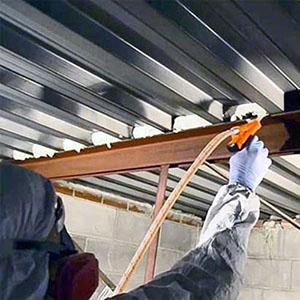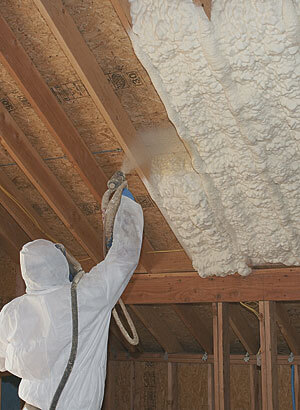Choosing the Right Type of Spray Foam for Your Insulation Demands
How Spray Foam Can Improve Power Efficiency in Any Kind Of Building
Spray foam insulation has actually become an essential solution for improving power efficiency throughout numerous building kinds. By developing an airtight seal that decreases air leakage, it properly regulates indoor environments while significantly lowering heating & cooling costs. In addition, its excellent R-value and moisture-resistant homes add to long-lasting energy cost savings and boosted structure long life. As property owners increasingly seek sustainable solutions, the implications of spray foam insulation prolong beyond simple energy cost savings. The complete range of its advantages, nonetheless, warrants a more detailed exam of how it can change power monitoring approaches in both residential and commercial setups.
Comprehending Spray Foam Insulation
Spray foam insulation is progressively identified for its exceptional thermal efficiency and adaptability in various applications. Composed largely of polyurethane, this insulation material is used as a fluid that expands upon call, filling up voids and producing a seamless obstacle. This one-of-a-kind residential or commercial property enables spray foam to adapt irregular surface areas, making it a perfect selection for both industrial and household structures.

Application of spray foam insulation is normally carried out by trained specialists utilizing specialized tools, making certain optimum performance and safety - Spray Foam. The treating procedure is rapid, permitting quick installment and minimal disturbance. Because of this, spray foam insulation is significantly being utilized in new building and retrofitting jobs as a result of its capability to improve structural integrity while boosting total energy effectiveness in buildings
Benefits of Power Efficiency
Energy performance plays an essential function in reducing operational expenses and reducing ecological effect throughout different fields. By maximizing power use, property owners and businesses can accomplish substantial cost savings on energy bills, which straight enhances financial efficiency. Efficient power consumption implies less reliance on nonrenewable fuel sources, therefore adding to a decrease in greenhouse gas exhausts and advertising an extra lasting environment.
Additionally, energy-efficient structures often experience boosted property worths. As energy costs rise and sustainability ends up being a priority for consumers, residential or commercial properties with improved power performance features are more eye-catching on the market. This trend encourages investment in energy-saving technologies, which can better drive technology and financial development.
Along with economic and environmental advantages, energy performance can likewise boost the total comfort and health and wellness of interior areas. Correct insulation and reliable heating and air conditioning systems assist keep constant temperature levels, lowering drafts and humidity degrees, which consequently can bring about much better indoor air quality.
Eventually, the advantages of power performance expand beyond instant financial savings, cultivating a durable economic situation, promoting environmental stewardship, and enhancing the quality of life for occupants in any structure.
Just How Spray Foam Works
Commonly used as a liquid, spray foam broadens rapidly upon contact with surfaces, developing a strong barrier that effectively seals splits and voids. This distinct property is because of its chemical make-up, mainly including polyols and isocyanates, which respond when blended to produce a foam that fills up spaces and sticks to different materials, consisting of metal, timber, and concrete.
When applied, the foam increases to numerous times its original volume, guaranteeing a limited seal that stops air leakage. This procedure dramatically decreases thermal linking, which takes place when warm transfers via materials, resulting in energy loss. The foam's high R-value, a step of thermal resistance, contributes to improved insulation by decreasing warmth transfer between the exterior and interior settings.
Furthermore, spray foam is resistant to dampness and parasites, additionally enhancing its efficiency in keeping energy performance. Its application can be customized to different locations, including attics, wall surfaces, and crawl spaces, maximizing insulation throughout a building. Spray Foam. On the whole, the ingenious design and application approach of spray foam make it an efficient solution for boosting power efficiency in any kind of structure, leading to minimized energy prices and a much more lasting built atmosphere

Applications in Different Structures
Various applications of spray foam insulation can be located across different structure types, improving power efficiency and comfort. In household homes, spray foam is typically made use of in wall surfaces and attics to produce a smooth obstacle against air leaks, substantially lowering heating and cooling demands. This application is specifically advantageous in older homes, where standard insulation might be poor.
In commercial buildings, spray foam insulation is applied to roofing systems and outside wall surfaces, which helps to improve thermal performance and secure versus moisture breach. Its light-weight nature makes it an ideal option for retrofitting existing structures without adding significant weight. Additionally, spray foam can be used in industrial settings to protect pipes and tank, preserving temperature level control for delicate products.
Institutional buildings, such as institutions and health centers, gain from spray foam insulation by guaranteeing a constant indoor climate that supports resident comfort and health. The versatility of spray foam allows it to adapt to various building forms and dimensions, making it a recommended selection for engineers and building contractors looking for reliable insulation remedies. On the whole, spray foam insulation acts as a critical part in accomplishing energy-efficient buildings across all sectors.
Long-Term Price Financial Savings
Spray foam insulation uses considerable long-term cost financial savings for structure owners and residents by reducing power consumption and reducing utility this hyperlink costs. By supplying an exceptional air seal, spray foam minimizes the seepage of outdoors air, consequently improving the thermal performance of a structure. This causes a lot more efficient home heating and cooling down processes, which can bring about significant reductions in energy prices gradually.
In addition to prompt cost savings on utility costs, the toughness and durability of spray foam insulation add to its address economic benefits. Unlike conventional insulation materials, which may sag, settle, or wear away, spray foam preserves its effectiveness for years, decreasing the need for constant substitutes or repair services. This durability translates to decrease maintenance costs and much less disruption for passengers.
In addition, structures outfitted with spray foam insulation commonly enjoy a rise in residential property worth, making them more attractive to possible customers or tenants. As energy effectiveness comes to be increasingly prioritized, buildings with effective insulation services stick out in the market. Ultimately, the integration of spray foam insulation not only boosts convenience yet also represents a calculated financial investment that produces substantial economic advantages over the long term.
Final Thought
To conclude, spray foam insulation offers as a vital element in boosting energy effectiveness throughout varied structure kinds. Its ability to develop a smooth barrier against air leak, incorporated with moisture-resistant buildings and high r-values, imp source substantially decreases power usage and associated expenses. The application of spray foam not just adds to constant interior temperature levels however likewise enhances home value, highlighting its function as a sensible investment for both domestic and industrial homes.
Spray foam insulation has emerged as a pivotal remedy for boosting energy efficiency throughout different building kinds. Spray Foam. As an outcome, spray foam insulation is increasingly being employed in brand-new building and construction and retrofitting tasks due to its capacity to improve structural integrity while boosting general power effectiveness in buildings
Generally, the innovative design and application approach of spray foam make it a reliable remedy for enhancing power efficiency in any framework, leading to lowered power prices and an extra sustainable built setting.
Various applications of spray foam insulation can be located across numerous building kinds, enhancing power efficiency and comfort.In verdict, spray foam insulation serves as an essential component in improving power efficiency throughout diverse building kinds.